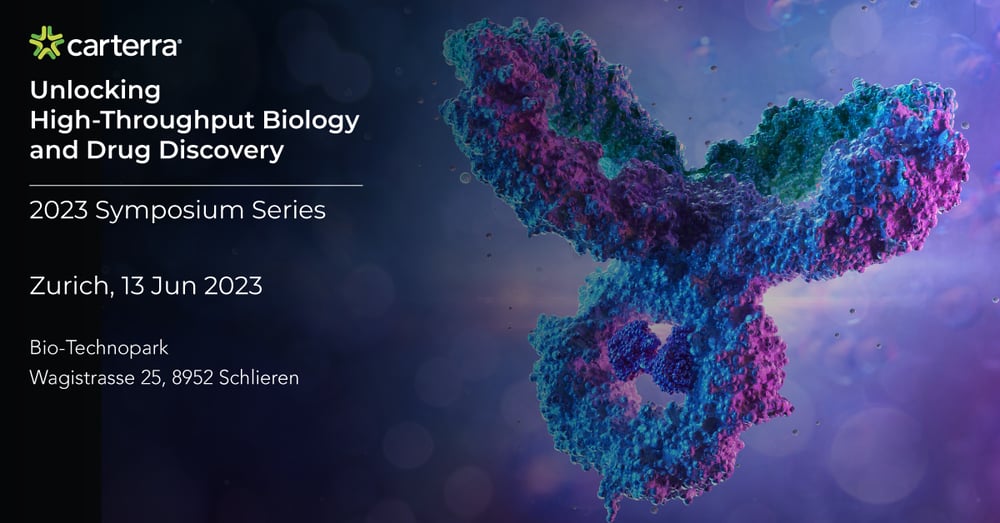
What You Will Learn
Please join Carterra at our upcoming symposium in Zürich, Switzerland. You will spend the day learning about high-throughput drug discovery and antibody therapeutics with some of the industry’s leading scientists. Our speakers will present new ways of looking at discovery, applications, and workflows, including HT-SPR. The topics you'll hear about include:
-
New methods in antibody discovery, DELs and PROTACs
-
Innovations using HT-SPR for drug discovery
-
Challenging assay formats, such as membrane targets and rapid binders
-
Strategies to streamline characterization workflows
-
Best practices in experimental design and analysis
Network with your peers. Lunch will be provided. Registration is required as seating is limited.
Register Here
Agenda |
|
|
08:45 – 09:00 |
Arrive and Check-in |
|
09:00 – 09:30 |
Networking and Coffee/Tea |
|
09:30 – 09:45 |
Symposium Begins—Welcome |
|
09:45 – 10:30 |
|
| Abstract: The Coronavirus Immunotherapeutics Consortium (CoVIC) is an international effort to conduct side-by-side, apples-to-apples comparison of leading therapeutic antibody candidates against the SARs-CoV-2 spike protein that were contributed by a range of large and small companies as well as academic groups on multiple continents. The CoVIC panel includes over 400 antibodies that originated from a variety of sources, including COVID-19 survivors and in silico design. All antibodies were sent to seven different partner reference labs for analyses of different antibody features, including in vivo protection in a mouse model of infection, affinity for spike protein, high resolution epitope binning, ability to block ACE-2 binding, neutralization of pseudovirus and authentic virus infection in cell culture, and Fc-mediated immune effector function. All data generated by the reference labs are accessible in the public database CoVIC-DB (https://covicdb.lji.org/). High-throughput, high resolution binning of CoVIC antibodies carried out using the Carterra LSA platform was particularly critical for defining the broad and nuanced landscape of antibody epitopes on the SARS-CoV-2 spike protein. This binning helped define epitopes that are associated with durable potency against multiple SARS-CoV-2 variants of concern, including Omicron, and also highlighted the competition profile of the CoVIC antibody panel. Results of CoVIC studies can be used to guide isolation of effective antibody therapeutics, selection of durable therapeutic cocktails, immunogen design. | |
|
10:30 – 11:00 |
|
|
|
Abstract: Selection of bi- and tri-specific binders often require the screening of large combinatorial sample sets derived from panels of single domain binders. The Carterra LSA platform makes analyzing the binding properties of these molecules straightforward and requires minimal amounts of mAb sample and antigen. The affinity of the binders to the targets can be measured in several assay formats and used to verify the independence and activity of each binding site for hundreds of clones. Along with the binding kinetics and specificity measurements, the LSA enables large scale epitope binning to ensure diverse sets of clones are being carried forward to functional evaluation. |
|
11:00 – 11:30 |
Break and Networking |
|
11:30 – 12:00 |

Heleen Vanhoolandt, Associate Scientist, Sanofi |
| Abstract: The variable domain of heavy chain-only antibodies from camelids, referred to as NANOBODY molecule, offers numerous advantages for the development of biological drugs. Sanofi Ghent has pioneered the development of this new modality. Following the classical drug development process, one of the most important parameters we are looking at in early screenings is the binding strength of the NANOBODY molecule to its target. This talk will highlight practical aspects and considerations to set up NANOBODY-specific binding assays on the Carterra LSA that have become broadly applicable during lead identification and characterization steps in the Discovery department of Sanofi Ghent. | |
|
12:00 – 13:00 |
Lunch and Networking |
|
13:00 – 13:30 |

Christian Stegmann, PhD, Senior Vice President, Drug Creation, Absci |
| Abstract: Artificial intelligence (AI) has the potential to greatly increase the speed, quality and controllability of drug creation. We showcase such potential on two antibody drug creation tasks: de novo design and lead optimization. For the first task, we utilize generative AI models for zero shot design of antibody CDRs. In particular, we screen over 1 million antibody variants designed for binding to human epidermal growth factor receptor 2 (HER2) using our high-throughput wet lab capabilities. Our models successfully design all CDRs in the heavy chain of the antibody and compute likelihoods that are calibrated with binding. We achieve binding rates that are several multiples higher than HCDR3s and HCDR123s randomly sampled from the Observed Antibody Space (OAS). We further characterize 421 AI-designed binders using surface plasmon resonance (SPR), finding three that bind tighter than the therapeutic antibody trastuzumab. The binders are highly diverse, have low sequence identity to known antibodies, and adopt variable structural conformations. For the second task, we show that our high-throughput screening assay can generate quantitative binding affinity scores for hundreds of thousands of antibody variants. After validating these scores with SPR, we use this data to train large language models that accurately predict binding affinities for unseen antibody variants. These models can be used to co-optimize multiple antibody properties, as we demonstrate by designing variants of trastuzumab with up to seven mutations and with over ten-fold increase in binding affinity. Combined, these approaches promise to accelerate and improve antibody drug creation, and may increase the success rates in developing novel antibody and related drug candidates. | |
| 13:30 – 14:00 |
|
| Abstract: The LSAXT expands the capabilities of HT-SPR to meet the demands of challenging assay formats. By building on the established benefits of HT-SPR including more data in less time with less sample, LSAXT has the versatility to address a range of experimental workflows. This talk will highlight how LSAXT is a robust platform for characterization of drug candidates including PROTAC®s and kinase inhibitors. The benefits of enhanced sensitivity and overall data quality in LSAXT take HT-SPR to a whole new level. | |
|
14:00 – 14:30 |
Break and Networking |
|
14:30 – 15:00 |

Kirsty McHugh, PhD, Senior Postdoctoral Scientist, University of Oxford |
| Abstract: Plasmodium falciparum malaria is a major cause of morbidity and mortality, and new interventions are urgently needed. The P.f reticulocyte-binding protein homolog 5 (PfRH5) antigen is a leading blood-stage vaccine candidate. Vaccines targeting PfRH5 have demonstrated antibody-mediated efficacy in clinical trials, but high, durable titers of antibodies must be induced, a difficult challenge for current generation vaccines. We have generated a panel of >200 anti-PfRH5 monoclonal antibodies from PfRH5-vaccinated UK adults. By using the Carterra LSA platform for HT-epitope binning alongside in vitro functional assays we have revealed the diverse antigenic landscape of PfRH5 and identified inhibitory epitopes to a fine resolution. | |
|
15:00 |
Symposium Ends |

 Judicaël Parisot, PhD,
Judicaël Parisot, PhD,  Noah T. Ditto, Technical Product Manager, Carterra
Noah T. Ditto, Technical Product Manager, Carterra